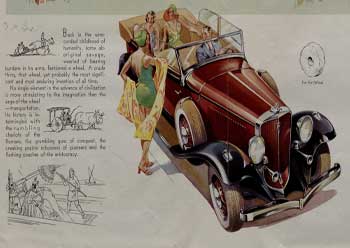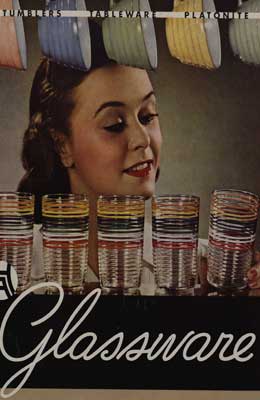Nature and Scope
Explore domestic life, leisure and the material culture of nineteenth- and twentieth-century America through the rich and varied material presented in Trade Catalogues and the American Home.

Introduction
Trade catalogues have been a prominent feature in commerce and manufacturing from the eighteenth century to the present day. Highly illustrated, they are an essential visual record of a variety of products and facilitate research into popular culture, material culture, social norms and attitudes, as well as the history of marketing, business, and technology.
These documents provide evidence of the evolution of distribution and communication systems linking manufacturers, wholesalers, retailers, and consumers across the emerging United States and beyond. They document the changing commercial tastes and fashions of the consumer over a period of rapid growth, expansion and crisis (both at home and overseas), revealing contemporary prices and economic expenditure for households and individuals on a range of products.
Interrogation of trade catalogues, trade cards and marketing ephemera provides opportunities for interdisciplinary research across the social sciences including:
Scope of the Collection
The wide range of industries and documents covered within this period allow researchers to explore: gender, class, changing social attitudes towards consumerism, the rise of the American Dream, and the response of American business to conflict. It is possible to explore the shaping of the United States in a century that witnessed the closing of the frontier, the mapping of states, domestic and international conflict, Reconstruction, the Great Depression – and the resulting cultural and societal changes including the role of women and material culture. Users can trace business history, the development of advertising, the rise and popularity of mail order shopping and department stores as well as changes in design, improvements in technology and the impact on domestic life using the material included within this resource.
University of California, Santa Barbara: Lawrence B Romaine collection
The Romaine Trade Catalogue Collection is named after Lawrence B Romaine (1900-1967), an antiquarian dealer who bought and sold rare books, manuscripts, trade catalogues and other Americana. During his time, Romaine was recognised in the U.S. as the leading expert on trade catalogues and was the author of A Guide to American Trade Catalogues, 1774-1900, the standard reference work in this field.
The Romaine Trade Catalogue Collection at UCSB contains more than 50,000 items, primarily 19th and early 20th century American trade and advertising literature including more than 41,000 trade catalogues from Romaine’s personal collection, gifted to the university archive. The collection includes content in every key area of domestic life from clothing, to dry goods, furniture and appliances.
The Romaine Trade Catalogue Collection is arranged by subject category, or 'Industry'. The material within Trade Catalogues and the American Home has been sourced from those categories within the Romaine Collection that fall within the scope of the resource and align with the key themes of domestic daily life and consumer culture. All material relating to domestic life and the home preserved within these categories has been digitised as part of this project. The organization of the content by subject area within the archive forms the basis for the arrangement of the digitised material in the resource where it is categorised by ‘Industry’. For more information on this, please see the Industries Page.
Winterthur Library and Hagley Museum and Library
The Winterthur Library have a strong trade catalogue collection with a particular focus in the decorative arts and design and a significant holding of trade cards. Material from Winterthur Library appearing in Trade Catalogues and the American Home include the Thelma Mendsen collection as well as material from the Winterthur Trade Catalogue Collection. These items enrich the domestic focus of the collection and reinforce the subject areas and industries represented within the Romaine Trade Catalogue Collection at UCSB.
Hagley Museum and Library have a particularly strength in the history of engineering, manufacturing, industry and technology, driven by the manufacturing heritage of the Du Pont family. Material included within Trade Catalogues and the American Home has been sourced from Hagley's TRCAT Library Stacks and their Consumer Goods Catalogues collections in order to enhance and complement the domestic focus of Trade Catalogues and the American Home.
Key themes
Significant products and services represented in the documents in this resource include Department Store Catalogues; Fashion and Clothing; Bicycles; Home Furnishings and Furniture; Food; Household Appliances; Cosmetics; Home Remedies and Health; and Sports, Leisure and Outdoor Pursuits amongst many others. The range of industries featured within this collection facilitate interdisciplinary research. Some of the keys themes include:
The range of industries featured within this collection facilitate interdisciplinary research. Some of the keys themes include:
Collection Highlights
- Catalogues from big-name department stores, such as Sears & Roebuck, Montgomery Ward, Charles William Stores, the National Cloak & Suit Co.
- Historic documents relating to popular brands including: Colgate, Ford, General Electric, General Motors, Spalding, Bloomingdale’s, Dodge, Kodak, Heinz, Hotpoint, Johnson & Johnson, Procter & Gamble, Remington, Spiegel, Wedgewood, and more.
- Documents covering all aspects of domestic life, enabling users to see transitions in lifestyle and developments in technology.
- Samples of materials, fabric, wallpaper, decorations and small products are featured within documents.
- A huge selection of material covering: Department Store Catalogues, Fashion and Clothing, Bicycles, Home Furnishings and Furniture, Food, Household Appliances, Cosmetics, Home Remedies and Health, and Sports and Leisure amongst many others.
A variety of secondary features provide further tools for teaching and research
Business biographies which introduce the history of household names that appeared during the nineteenth and twentieth centuries.
Online exhibitions focusing on the rise of labour-saving domestic appliances.
Contextual essays from scholars in a variety of fields which demonstrate the interdisciplinary nature of the material.
Visual highlights galleries showcasing the visual gems of the collection.
Language and Terminology
All editorial decisions relating to this project have been made with great care, consideration and with the utmost sensitivity.
Every care and attention has been paid to preserve the historic authenticity of these documents which range in date from the middle of the nineteenth, to the middle of the twentieth century. Any terminology that may be deemed discriminatory or offensive by present-day principles may have been preserved for the historic accuracy and relevance to that particular document.



![[Trade card for Coca-Cola]](/ContributeData/TradeCatalogues/Views/Introduction/Nature-and-Scope-4.jpg)